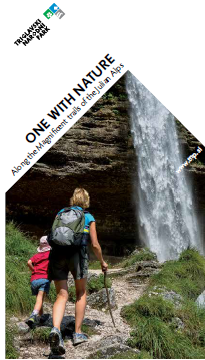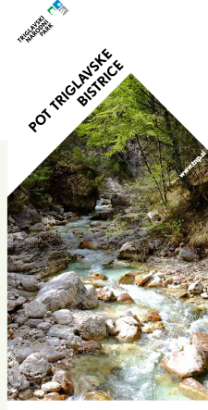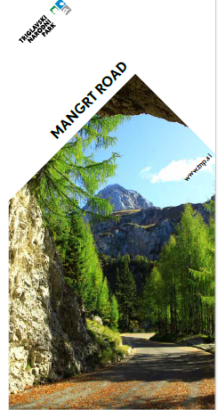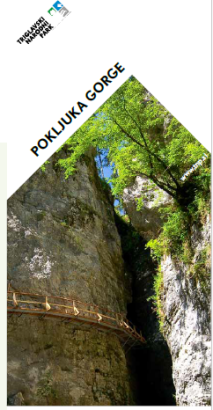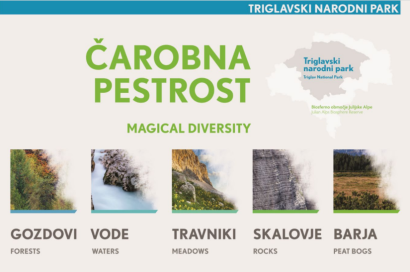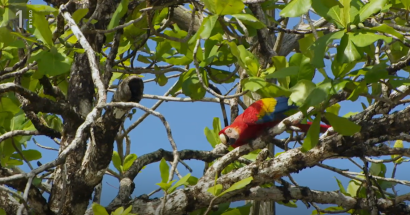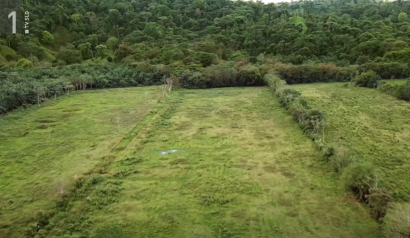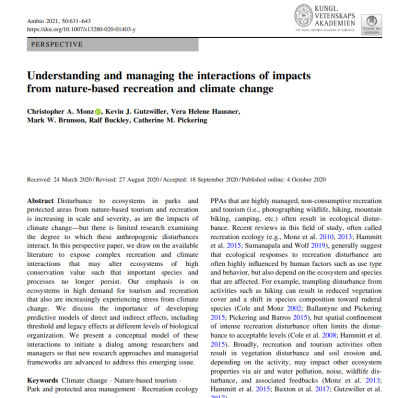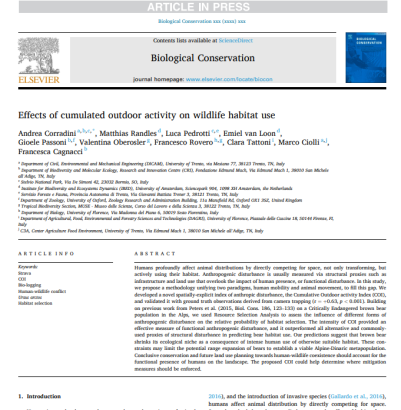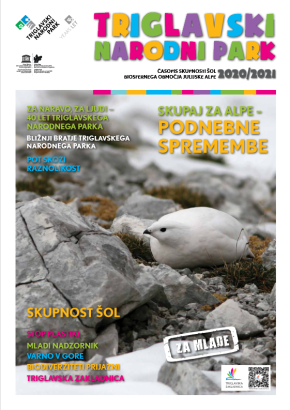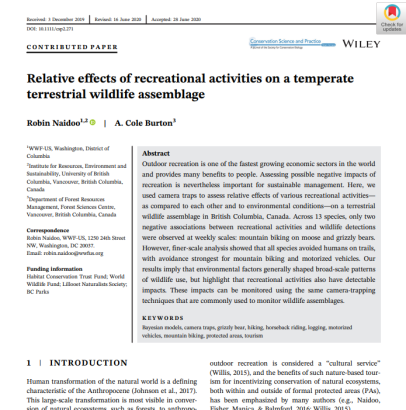Digital library
Showing results 48 - 60/151
Triglav National Park leaflets (On the beautiful trails of the Julian Alps)
The leaflets provide information on various topics related to the Triglav National Park.
Source
TNP Publications, Triglavski narodni park
Year
2020
Type
Magazine
Format
Document (PDF, DOC, ...)
Keywords
Leaflets
Links
Območja
Triglav National Park
Triglav National Park leaflets (The Triglav Bistrica Trail in the Vrata Valley)
The leaflets provide information on various topics related to the Triglav National Park.
Source
TNP Publications, Triglavski narodni park
Year
2020
Type
Magazine
Format
Document (PDF, DOC, ...)
Keywords
Leaflets
Links
Območja
Triglav National Park
Triglav National Park leaflets (Mangrt Road)
The leaflets provide information on various topics related to the Triglav National Park.
Source
TNP Publications, Triglavski narodni park
Year
2020
Type
Magazine
Format
Document (PDF, DOC, ...)
Keywords
Leaflets
Links
Območja
Triglav National Park
Triglav National Park leaflets ( Pokljuka Gorge)
The leaflets provide information on various topics related to the Triglav National Park.
Source
TNP Publications, Triglavski narodni park
Year
2020
Type
Magazine
Format
Document (PDF, DOC, ...)
Keywords
Leaflets
Links
Območja
Triglav National Park
Occasional publications (Exhibition Magical Diversity)
The Triglav National Park also publishes occasional publications. They cover various topics in the fields of nature conservation, cultural heritage, research, education, etc.
Source
TNP Publications, Triglavski narodni park
Year
2020
Type
Magazine
Format
Document (PDF, DOC, ...)
Keywords
Others
Območja
Triglav National Park
Biodiversity in the Tropical Forest - Costa Rica
TV Slovenia, in collaboration with the National Institute of Biology, presents a film about one of the world’s biodiversity hotspots: Costa Rica.
When the landmass that includes present-day Costa Rica rose from the sea three million years ago, it connected the life of two great continents, igniting one of the hottest biodiversity hotspots on Earth. Nowhere else in the world are there as many habitats as in Costa Rica, a small country bridging North and South America. On a territory just twice the size of Slovenia, it is home to so many species that they represent almost 5% of the world’s biodiversity.
Costa Rica’s pristine rainforests are home to 500,000 plant and animal species, including those at the top of the endangered species list, such as the popular ara macao (scarlet macaw). The film takes us through the formation of the tropical rainforest, which hides many wonders in its wilderness, including its exoticism, deadliness, and the incredible ingenuity of plants and animals.
The rich life of tropical fauna and flora is explained by the film’s expert collaborators, Prof. Dr. Marina Dermastia from the National Institute of Biology and Prof. Dr. Tom Turk from the Biotechnical Faculty of the University of Ljubljana, who have led professional student expeditions to this small paradise on Earth for many years.
Source
RTV Slovenia (RTV365)
Year
2020
Type
Video clip
Format
Video
Keywords
biodiversity, tropical forest, Costa Rica, wildlife, deforestation, pollution, fauna, flora
Območja
World
Return to the Virgin Forest - Costa Rica
TV Slovenia, in collaboration with the National Institute of Biology, presents a film about one of the world's biodiversity hotspots: Costa Rica.
Life in Costa Rica has been deeply influenced by the American corporation United Fruit Company (UFC). The deforestation caused by the establishment of banana plantations severely disrupted tropical ecosystems. The relentless pursuit of profit and intensive cattle ranching reduced Costa Rica’s forest cover to a mere 26% of the country, destroyed primary habitats, and fragmented forested areas. When UFC left Costa Rica, it left behind thousands of unemployed workers and hundreds of hectares of abandoned plantations.
Costa Ricans converted some of these abandoned plantations into oil palm and pineapple plantations, while the rest were reforested with the help of international non-governmental organizations. They also began connecting islands of secondary tropical forest into biological corridors, allowing plants and animals to migrate and thrive. Tropical ecosystems are not only home to 85% of all living species but also serve as the lungs of our planet. A single tropical tree can absorb nearly 12 kg of carbon dioxide annually. By reforesting devastated areas, Costa Rica is also reducing the concentration of greenhouse gases in the atmosphere.
The film takes viewers through the regrowth of tropical forests on abandoned plantations and grasslands, highlighting the key challenges of reforestation at a tropical research station located in the heart of the rainforest in La Gamba.
Source
RTV Slovenia (RTV365)
Year
2020
Type
Video clip
Format
Video
Keywords
biodiversity, tropical forest, Costa Rica, wildlife, deforestation, pollution, fauna, flora
Območja
World
Understanding and managing the interactions of impacts from nature-based recreation and climate change
Disturbance to ecosystems in parks and protected areas from nature-based tourism and recreation is increasing in scale and severity, as are the impacts of climate change—but there is limited research examining the degree to which these anthropogenic disturbances interact. In this perspective paper, we draw on the available literature to expose complex recreation and climate
interactions that may alter ecosystems of high conservation value such that important species and processes no longer persist. Our emphasis is on ecosystems in high demand for tourism and recreation that also are increasingly experiencing stress from climate change. We discuss the importance of developing
predictive models of direct and indirect effects, including
threshold and legacy effects at different levels of biological
organization. We present a conceptual model of these
interactions to initiate a dialog among researchers and
managers so that new research approaches and managerial
frameworks are advanced to address this emerging issue.
Source
ResearchGate, Ostalo
Year
2020
Type
Original scientific article
Format
Website
Authors
Christoper A. Monz, Kevin J. Gutzwiller, Vera Helen Hausner, Mark W. Brunson, Ralf Christopher Buckley, Catherine M. Pickering
Keywords
Climate change, Nature-based tourism, Park and protected area management, Recreation ecology
Območja
World
Occasional publications (Elektronski zbir dobrih praks na področju blaženja podnebnih sprememb in prilagajanja nanje na Biosfernem območju Julijske Alpe )
The Triglav National Park also publishes occasional publications. They cover various topics in the fields of nature conservation, cultural heritage, research, education, etc.
Source
TNP Publications, Triglavski narodni park
Year
2020
Type
Magazine
Format
Document (PDF, DOC, ...)
Keywords
Others
Območja
Triglav National Park
Effects of cumulated outdoor activity on wildlife habitat use
Humans profoundly affect animal distributions by directly competing for space, not only transforming, but actively using their habitat. Anthropogenic disturbance is usually measured via structural proxies such as infrastructure and land use that overlook the impact of human presence, or functional disturbance. In this study,
we propose a methodology unifying two paradigms, human mobility and animal movement, to fill this gap. We developed a novel spatially-explicit index of anthropic disturbance, the Cumulative Outdoor activity Index (COI), and validated it with ground truth observations derived from camera trapping (r = +0.63, p < 0.001). Building on previous work from Peters et al. (2015, Biol. Cons. 186, 123–133) on a Critically Endangered brown bear population in the Alps, we used Resource Selection Analysis to assess the influence of different forms of anthropogenic disturbance on the relative probability of habitat selection. The intensity of COI provided an
effective measure of functional anthropogenic disturbance, and it outperformed all alternative and commonlyused proxies of structural disturbance in predicting bear habitat use. Our predictions suggest that brown bear shrinks its ecological niche as a consequence of intense human use of otherwise suitable habitat. These constraints may limit the potential range expansion of bears to establish a viable Alpine-Dinaric metapopulation. Conclusive conservation and future land use planning towards human-wildlife coexistence should account for the functional presence of humans on the landscape. The proposed COI could help determine where mitigation measures should be enforced.
Source
ResearchGate
Year
2020
Type
Research
Format
Website
Authors
Andrea Corradini, Matthias Randles, Luca Pedrotti, Emiel von Loon, Gioele Passoni, Valentina Oberosler, Francesco Rovero, Clara Tattoni, Marco Ciolli, Francesca Cagnacci
Keywords
Strava, COI, bio-logging, human-wildlife conflict, Ursus arctos, habitat selection
Območja
World
Children's newspaper (Časopis Skupnosti šol Biosfernega območja Julijske Alpe 2020 / 2021)
Source
TNP Publications, Triglavski narodni park
Year
2020
Type
Magazine
Format
Document (PDF, DOC, ...)
Keywords
Children's material
Območja
Triglav National Park
Relative effects of recreational activities on a temperate terrestrial wildlife assemblage
Outdoor recreation is one of the fastest growing economic sectors in the world and provides many benefits to people. Assessing possible negative impacts of recreation is nevertheless important for sustainable management. Here, we used camera traps to assess relative effects of various recreational activities—as compared to each other and to environmental conditions—on a terrestrial wildlife assemblage in British Columbia, Canada. Across 13 species, only two negative associations between recreational activities and wildlife detections were observed at weekly scales: mountain biking on moose and grizzly bears. However, finer-scale analysis showed that all species avoided humans on trails, with avoidance strongest for mountain biking and motorized vehicles. Our results imply that environmental factors generally shaped broad-scale patterns of wildlife use, but highlight that recreational activities also have detectable impacts. These impacts can be monitored using the same camera-trapping techniques that are commonly used to monitor wildlife assemblages.
Source
ResearchGate
Year
2020
Type
Original scientific article
Format
Website
Authors
Robin Naidoo, A. Cole Burton
Keywords
Bayesian models, camera traps, grizzly bear, hiking, horseback riding, logging, motorized vehicles, mountain biking, protected areas, tourism
Območja
World
Was this page helpful?
Thank you
Thank you.

